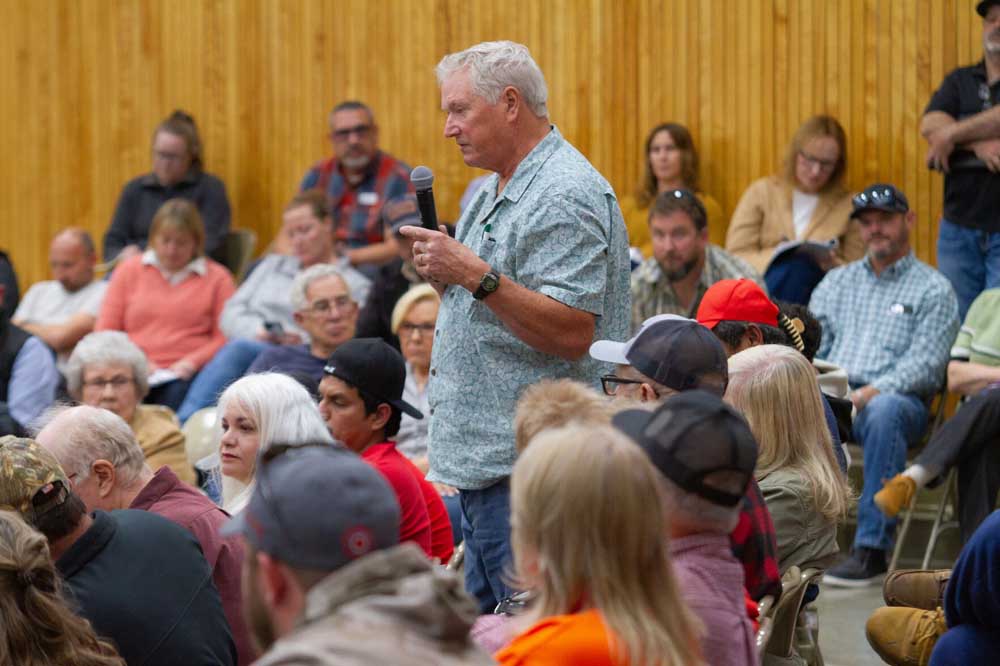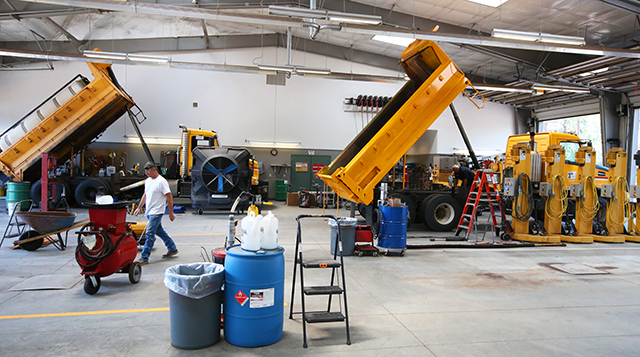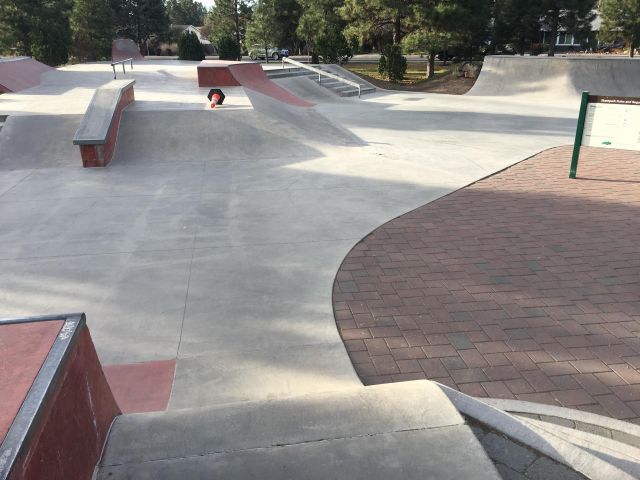Leaders of 3 state agencies meet with Eastern Oregon residents on nitrate pollution
Published 5:00 am Monday, April 22, 2024

- Greg Pettit, of St. Helens, tells Oregon agency department heads the state needs to change its priorities to address groundwater contamination April 18, 2024, at public meeting in Boardman.
BOARDMAN — Area residents pressed leaders of three state agencies during a meeting Thursday night, April 18, about ongoing nitrate pollution in residential wells in Umatilla and Morrow counties.
Oregon Department of Environmental Quality Director Leah Feldon, Oregon Department of Agriculture Director Lisa Charpilloz Hanson and Oregon Water Resources Department Acting Director Doug Woodcock sought to address almost 100 community members’ frustrations about groundwater contamination in the Lower Umatilla Basin Groundwater Management Area.
Trending
A representative from the Oregon Health Authority, Gabriela Goldfarb, environmental public health section manager, also was present to answer questions about the public health aspects associated with the pollution at the end of the meeting.
Directors emphasize commitmentCharpilloz Hanson said during the meeting she hoped having three state department heads at a public meeting showed the community they are committed to “doing the work we need to do moving forward to help improve the groundwater” in the basin.
“We’re here to work in partnership with the community, with the producers, and really approach this from a holistic perspective,” she said.
She also said the state Agriculture Department typically works with surface water, rather than groundwater, but the agency is working with the local soil and water conservation district to build effective plans to regulate groundwater.
Feldon said protecting the quality of groundwater that flows into people’s domestic wells is the responsibility of the DEQ.
“We have not done enough,” she said at the start of the meeting. “In addition to the public health efforts to ensure that people have access to clean drinking water, we must, as a region and as a state, do more to reduce the nitrate levels in the groundwater.”
Trending
Feldon talked about the complex nature of eliminating nitrates from groundwater supplies, and how the solution will be multifaceted. She discussed how DEQ wastewater permits play a role in limiting how much high-nitrate wastewater is dumped into agricultural areas.
Finally, Woodcock with the Water Resources Department discussed how regulating and monitoring water resources and well construction plays into the issue of contaminated groundwater in agricultural areas.
“Our technical staff that are working in the basin are measuring water levels, they’re tracking the water level trends across the basin,” he said. “They’re mapping the wells in the basin.”
The department’s work should give insight into how the groundwater flows in the region, which affects how the nitrate concentration changes throughout the area.
“It’s going to need to be grounded in science,” Woodcock said of the solution to the contamination. “It’s going to need to be collaborative with all of our community people, and that also includes our industry partners, as well.”
Community asks for actionMany people in the audience wore red to indicate their association with Oregon Rural Action, a La Grande-based nonprofit and community organizing group promoting clean water, air and land.
Feldon said it’s tough to give an exact timeline because “remediating groundwater in that true sense, scientifically, that does not happen in the short term.”
Even if sources of contamination stopped adding nitrates, the well water still would be contaminated. So, getting nitrates out of the groundwater will take longer than addressing the immediate public health need for clean drinking water. The Oregon Health Authority continues to provide water bottles and treatment systems.
Feldon said there need to be conversations between the state agencies and the counties to figure out what infrastructure could look like to get residents clean drinking water and then start working on that. The longer-term solutions will require reducing the input of nitrates into the groundwater.
“It’s not fair to ask a community to wait decades for clean drinking water,” she said, “so I really try and think of what we need to do here in those three different ways, and we need to be putting our efforts into all of them but being realistic that the groundwater isn’t going to get healthy overnight.”
In terms of solutions, Feldon said, one thing the DEQ can do is ensure the permits are better than they have been in the past, and that’s what the agency has been doing in recent years. It has added more monitoring and reporting, limited winter application and started requiring treatment as part of the permit in some cases.
These actions, she said, will “eventually take industrial wastewater out of the equation completely in terms of one of the contributors.”
Industrial wastewater application — applying reused water to fields — contributes about 5% of the overall nitrate contamination in the basin. It’s estimated that irrigated farmland and concentrated animal feeding operations, dairy and cattle farms, make up about 83% — 70% and 13%, respectively — of the overall nitrate contamination.
This falls more under the agriculture department’s jurisdiction, except that historically, it has focused on surface water instead of groundwater.
Charpilloz Hanson said because agricultural needs vary so much across operations due to size and kind, there cannot be a one-size-fits-all approach. Instead, it must be a combination of factors coming together while making sure actions aren’t pushing the nitrates deeper into the soil.
The next stepsThroughout the meeting, the directors emphasized that whatever steps happen next, they must be taken collectively with all the parties involved in the decision-making process.
“There’s collaboration going on between these agencies that I really don’t think has gone on in this manner,” said Feldon. “The reality is that our jurisdictions overlap.”
She said the agencies are working with the U.S. Environmental Protection Agency to put all the data sets together under one system to see how all the information interacts holistically. Additionally, she said Gov. Tina Kotek has been helpful in committing resources to the situation.
“I think that it’s through those conversations that we really start to get a better plan for the future,” she said.
In addition to meeting with members of the public April 18, the three agency directors also met with the LUBGWMA Committee on April 19. In that meeting, the directors heard from and talked to leaders from different interest groups, such as environmental organizations, local and tribal governments and industry representatives, about their needs.
Oregon Consensus, an organization that helps facilitate complex meetings and decisions, will be asking members of the committee questions, in something like a survey, over the next month or so. Then, Oregon Consensus will then recommend how to proceed, likely by bringing in a facilitator who will help run the meetings so everyone can focus on representing their groups’ interests.
The facilitator model worked well in a similar situation in Walla Walla, according to testimony from Chris Marks with the Confederated Tribes of the Umatilla Indian Reservation. More information on this additional resource will come in the next few months.
Additionally, in the LUBGWMA Committee meeting, members asked the directors if they would consider formalizing their agencies’ commitment to this issue in writing. DEQ director Feldon indicated a statement of intent or similar documentation would be a good idea.
Community organizers unsatisfiedGreg Pettit, a retired DEQ administrator and member of Oregon Rural Action, made a comment near the end of the public meeting.
“I think the state agencies have really fallen down and not met their responsibilities when it comes to this groundwater issue,” he said. “It’s a critical public health issue that’s not being adequately addressed, and it’s a perfect example of an environmental injustice.”
After it concluded, Nella Parks, a senior organizer with Oregon Rural Action, said she was not satisfied. She said she would’ve liked to hear the agencies are planning to impose stricter standards on industry in the area, but it doesn’t sound like that’s what’s happening.
“As long as the polluters’ needs are their primary concern, we aren’t going to get what we want,” Parks said, “and what we see is that DEQ and OHA, and especially ODA, their concern is not on the actual downstream effect of what’s happening in people’s homes and in their lives.”
Agencies acknowledge impactParks also said she felt the agencies did not give clear steps for what they are going to change and how that will lower the contamination.
“They come here and they talk in policy mumbo jumbo instead of just saying, ‘This is wrong, and it’s unacceptable, and here are the concrete steps we’re going to take to change it as quickly as possible,’” she said. “That’s not what we heard. We heard, ‘Oh, it’s going to take time, be patient, thanks for your patience.’”
However, Feldon said at the start of the meeting that what’s been done isn’t enough.
After the meeting, Charpilloz Hanson said, “I think we all recognize as agencies that we need to do better and do more.”
The meeting in Boardman was the first step toward that, she said.
“It’s important to the community,” she added, “and it’s moving, emotionally, to know how much help they need and so I don’t want that to go unnoticed, that people are looking for help.”








